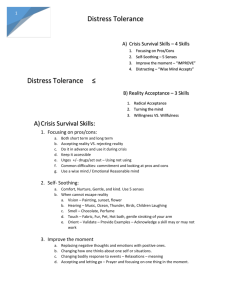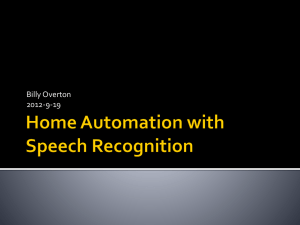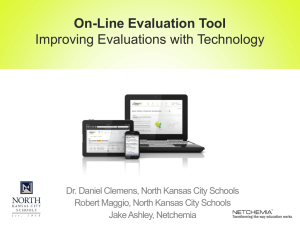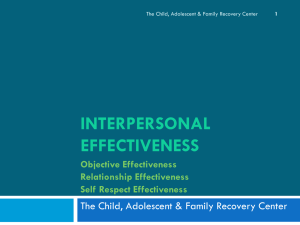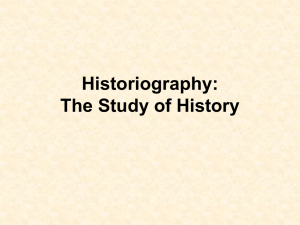Distress Tolerance - The Child, Adolescent and Family Recovery
advertisement
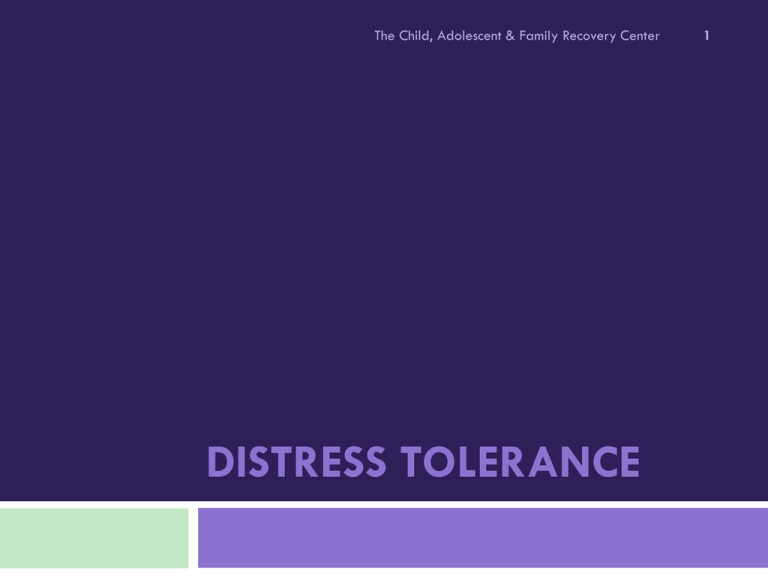
The Child, Adolescent & Family Recovery Center DISTRESS TOLERANCE 1 Distress Tolerance 2 We use this skill when we are having impulse control problems. Problem Solving Strategies This skills offers Crisis Survival strategies. It is also used as an attempt to accept reality. The Child, Adolescent & Family Recovery Center Distress Tolerance Pros and Cons Crisis Survival Network (CSN) K.I.I.P. Half Smiling OBJECTIVES SPECIFIC PATHS DISTRACT with “Wise Mind ACCEPTS” SELF-SOOTHE The Five Senses IMPROVE the moment Observe Breathing Radical Acceptance Distract with “Wise Mind ACCEPTS” 4 The Child, Adolescent & Family Recovery Center Observe Your Breathing Inhale while counting to five slowly Let the breath out while counting to five slowly Repeat Take a deep breath while taking one long stride Let out deep breath while taking one long stride. Repeat “These exercise is designed to help you deal with crisis, stress and/or difficulties…” Getting grounded with you breathing is something you can do anywhere and in any situation Self-Soothe the Five Senses 6 Smell Create a SelfSoothe 1st Aid Kit The Child, Adolescent & Family Recovery Center IMPROVE the Moment 7 Imagery Meaning Prayer Relaxation One thing at a time Vacation Encouragement The Child, Adolescent & Family Recovery Center Pros and Cons 8 Make one list of pros and cons of tolerating distress and another list of pros and cons of not tolerating the distress. Focus on long term goals “the light at the end of the tunnel.” Think of the positive consequences of tolerating the distress- Imagine in your mind how good you will feel if you achieve your goals and don’t act impulsively. Think of the negative consequences of not tolerating your current distress. The Child, Adolescent & Family Recovery Center Pros and Cons Pros of Having Drama and Stress Cons of NOT having Drama and Stress Cons of having Drama and Stress Pros of NOT having Drama and Stress Crisis Survival Network (CSN) This is a list of people who support you in the middle of a crisis or a problem. Mentors Family members Non-using friends Sponsor Teacher Therapist Support Groups that you can attend 12-step ANAD CAFRC Half-Smile “By having a small genuine smile on your face, you are less tense in your face, neck and shoulders.” Try and find something to smile about, even in an extremely difficult situation. Finding at least one little thing to have a small and genuine smile about. Having BALANCE! When things are difficult, think about when things are easy When you don’t get your way, think about a time that you did “Hold this ‘half-smile’ with the stress and difficulty you are currently experiencing.” SPECIFIC PATHS What is my upreme Concern? ractice my skills Focus my nergy and Concentration can be effective Have aith Figure out what is mportant Have ourage and atience Pay ttention Complete asks Be umble and have ensitivity “This acronym is designed to help you stay on the path to building the life you want for yourself” (Moonshine) OBJECTIVES ne thing at a time e effective “You can effectively deal with difficult experiences by using this acronym. It helps to practice using the acronym BEFORE you really need it” (Moonshine) Avoid udgments Cope with motions Consider onsequences Take ime Use ntrospection Act consistently with alues Focus on desired ndings Balance hort-term and long term goals 14 “All the things you think you should have done that you did not do, and all of the things that you should not have done, accept them. You did (or did not) do them. That's reality. That's happened. No changing the past.” ~Peter McWilliams The Child, Adolescent & Family Recovery Center Accepting Reality 15 “Some people confuse acceptance with apathy, but there is all the difference in the world. Apathy fails to distinguish between what can and what cannot be helped; acceptance makes that distinction. Apathy paralyzes the will-to-action; acceptance frees it by relieving it of impossible burdens.” ~Arthur Gordon The Child, Adolescent & Family Recovery Center Radical Acceptance 16 Freedom from suffering requires ACCEPTANCE from deep within of WHAT is ACCEPTANCE is acknowledging WHAT is To ACCEPT something is NOT the same as judging good. The Child, Adolescent & Family Recovery Center Willingness versus Willfulness 17 Cultivate a WILLING response to each situation Willingness is doing just what is needed in each situation, in an unpretentious way. It is focusing on effectiveness Willingness is listening very carefully to your WISE MIND, acting from your inner self Willingness is ALLOWING into awareness your connection to the universe- to the earth to the floor you are standing upon, to the person you are interacting with The Child, Adolescent & Family Recovery Center Willingness versus Willfulness 18 Replace WILLFULNESS with WILLINGNESS Willfulness is sitting on your hands when action is needed, refusing to make changes that are needed Willfulness is giving up Willfulness is the opposite of “doing what works,” or being effective Willfulness is trying to fix every situation Willfulness is refusing to tolerate the moment The Child, Adolescent & Family Recovery Center Keep It In Perspective (K.I.I.P.) If you don’t know what’s important Then everything is important If everything is important Then you try to do everything If you are attempting to do everything Then people expect you do do everything And in trying to please everybody Then you don’t have time to determine What is important to you Behavioral Chain Analysis Problem Bx Vulnerability Factor Chain of Events Consequences of the Problem Behavior Skills that could have been used during the chain of event Consequences of using the skills
